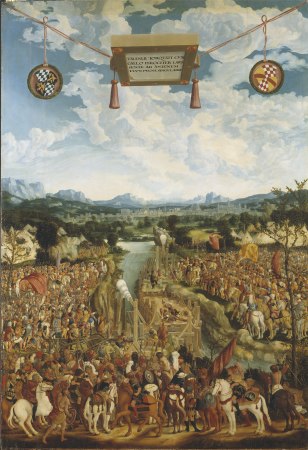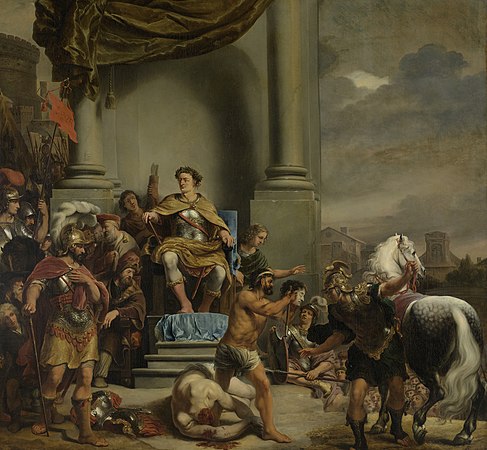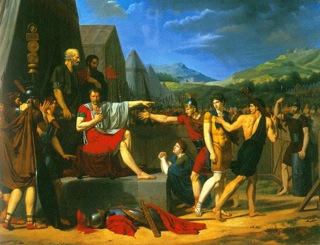Titus Manlius Imperiosus Torquatus

Titus Manlius Imperiosus Torquatus was a famous politician and general of the
Career
Titus's father Lucius was appointed dictator in 363 BC in order to fulfil religious duties, but instead undertook preparations for war. This resulted in strong opposition from the plebeian tribunes and he was brought to trial at the beginning of the next year, after he had resigned the dictatorship. Amongst the charges against him was that he had banished Titus from Rome on account of his speaking difficulties and made him work as a labourer.[2] Upon hearing of these accusations against his father, Titus went to the home of the tribune Marcus Pomponius, where he was expected by the latter to provide further charges and was thus promptly admitted. However, once they were alone, he drew his hidden knife and threatened to stab the tribune unless he made a public oath not to hold an assembly to accuse Lucius Manlius, which Pomponius agreed to and duly performed. Titus Manlius' reputation grew on account of his filially pious actions, which helped him to be elected as a military tribune later in the year.[3]
In 361 BC, Titus Manlius fought in the army of
In 353 BC, he was named dictator and prepared to attack Caere, but they responded by sending envoys and were granted peace. The campaign was then directed towards the Falisci, but the Roman army found on arrival that the Falisci had disappeared. They ravaged the land but spared the cities before returning to Rome.[5] He was appointed dictator again in 348 BC to oversee elections. A year later, he was elected to his first consulship. His second consulship came in 345 BC.
In 340 BC, when Manlius was consul for the third time, Rome had leadership over the

During the conduct of the war, Manlius and his co-consul,
After Decius Mus sacrificed himself to achieve victory at the battle of Vesuvius, Manlius was able to crush the Latin allies and pursue them into Campania. He defeated them again at Trifanum, bringing the war to an end, and returned to Rome. He was unable on account of ill health to conduct a further campaign against the Antiates and appointed Lucius Papirius Crassus as dictator to fulfil this role instead.[7]
Legacy
In painting
-
Manlius' duel against the Gaul, a typical battle scene of the Renaissance by the German Ludwig Refinger (mid 16th century).
-
The Dutch Baroque painter Ferdinand Bol depicted the son's decapitation (1661–64).
Sacrifice to the state was one of the favourite themes of French Neoclassical painters at the end of the 18th century and especially during the French Revolution. The story of Torquatus' execution of his son was logically used by several of them.[8]
-
Jean-Simon Berthélemy (1785).
-
Alphonse Gaudar de Laverdine (1799).
-
Alexandre-Romain Honnet (1799).
Stemma of the Manlii Torquati
Stemma taken from Münzer until "A. Manlius Torquatus, d. 208", and then Mitchell, with corrections. All dates are BC.[9][10]
|
Dictator
|
|
Censor |
|
Consul | ||||||||||||||||||
T. Manlius Imperiosus Torquatus dict. 353, 349, 320 cos. 347, 344, 340 | |||||||||||||||||||||||||||||||||||||||||||||||
| T. Manlius Torquatus d. 340 | |||||||||||||||||||||||||||||||||||||||||||||||
| T. Manlius Torquatus cos. 299 | L. Manlius Torquatus legate 295 | ||||||||||||||||||||||||||||||||||||||||||||||
| T. Manlius Torquatus | |||||||||||||||||||||||||||||||||||||||||||||||
| T. Manlius Torquatus | A. Manlius Torquatus Atticus cens. 247; cos. 244, 241 | ||||||||||||||||||||||||||||||||||||||||||||||
| T. Manlius Torquatus cos. 235, 224 cens. 231; dict. 208 | |||||||||||||||||||||||||||||||||||||||||||||||
| A. Manlius Torquatus d. 208 | |||||||||||||||||||||||||||||||||||||||||||||||
| T. Manlius Torquatus cos. 165 | A. Manlius Torquatus cos. 164 | ||||||||||||||||||||||||||||||||||||||||||||||
| T. Manlius Torquatus pr. 137 | D. Junius Silanus Manlianus pr. 141, d. 140 | ||||||||||||||||||||||||||||||||||||||||||||||
| T. Manlius Torquatus | L. Manlius Torquatus qu. circa 113 | A. Manlius Torquatus | |||||||||||||||||||||||||||||||||||||||||||||
| T. Manlius Torquatus pr. 69 | P. Cornelius Lentulus Spinther (adopted) augur 57 | Manlia | L. Manlius Torquatus cos. 65 | A. Manlius Torquatus pr. 70 | |||||||||||||||||||||||||||||||||||||||||||
L. Manlius Torquatus pr. 49 | A. Manlius Torquatus qu. 43, pontifex | A. Manlius Torquatus | T. Manlius Torquatus | ||||||||||||||||||||||||||||||||||||||||||||
See also
References
- ^ "Titus Manlius te paard". lib.ugent.be. Retrieved 2020-10-02.
- ISBN 978-0-14-044388-2.
- ^ Livy 1982, p. 103
- ^ Livy 1982, p. 109
- ^ Livy 1982, pp. 123–124
- ISBN 0-415-12167-1.
- ^ Cicero, Marcus (1927). The Life of Cicero. London: Bradbury & Evans. p. 469. Retrieved 7 June 2015.
- ^ Rosenblum, Transformations, p. 67.
- ^ Mitchell, "The Torquati".
- ^ Münzer, PW, vol. 27, pp. 1181-1182.
Bibliography
Ancient works
- Titus Livius (History of Rome.
- Valerius Maximus, Factorum ac Dictorum Memorabilium (Memorable Deeds and Sayings).
Modern works
- T. Robert S. Broughton, The Magistrates of the Roman Republic, American Philological Association, 1952–1986.
- Michael Crawford, Roman Republican Coinage, Cambridge University Press, 1974–2001.
- Jane F. Mitchell, "The Torquati", in Historia: Zeitschrift für Alte Geschichte, vol. 15, part 1, (January 1966), pp. 23–31.
- Friedrich Münzer, Roman Aristocratic Parties and Families, translated by Thérèse Ridley, Johns Hopkins University Press, 1999 (originally published in 1920).
- Realencyclopädie der Classischen Altertumswissenschaft(abbreviated PW), J. B. Metzler, Stuttgart (1894–1980).
- Robert Rosenblum, Transformations in Late Eighteenth Century Art, Princeton University Press, 1967.
- Lily Ross Taylor and T. Robert S. Broughton, "The Order of the Two Consuls' Names in the Yearly Lists", Memoirs of the American Academy in Rome, 19 (1949), pp. 3–14.
- R. M. Ogilvie (editors), The Cambridge Ancient History, vol. VII, part 2, The Rise of Rome to 220 B.C., Cambridge University Press, 1989.





